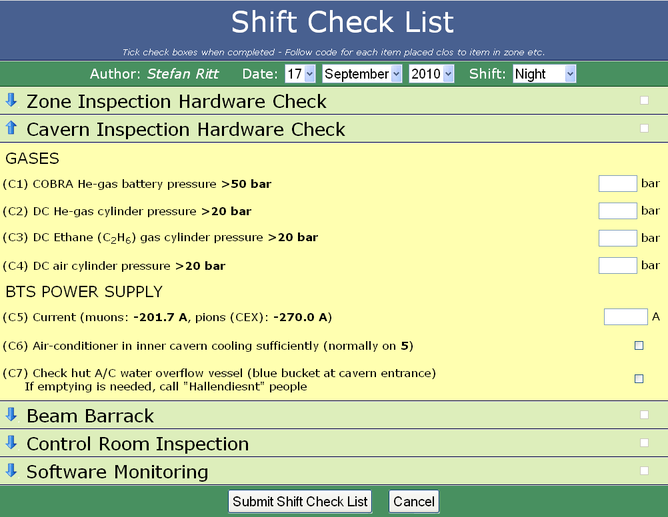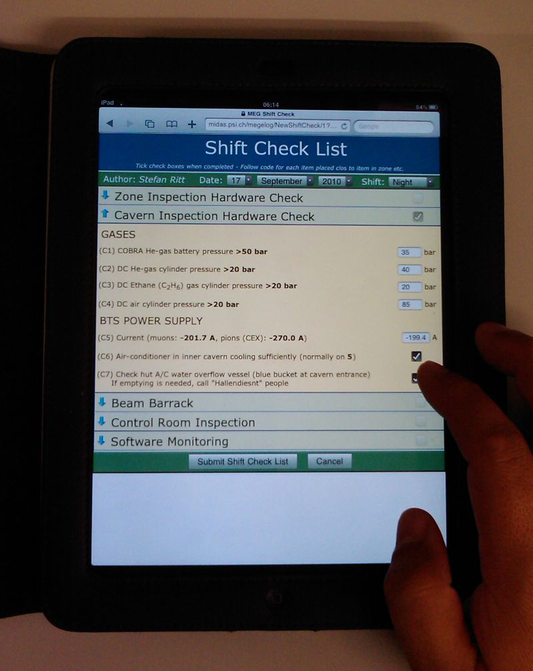 Re: how to convert Common Era (C.E.) into Buddhist Era , posted by Stefan Ritt on Wed Sep 15 01:02:26 2010
Re: how to convert Common Era (C.E.) into Buddhist Era , posted by Stefan Ritt on Wed Sep 15 01:02:26 2010
|
| phichitpon wrote: |
|
how to convert Common Era (C.E.) into Buddhist Era such as C.E. 2010 to B.E. 2553 (2553=2010+543) .thank you
|
Uh, thank you for teaching me that something like B.E. exists. I didn't know before. Unfortunately elog relied on the underlying operating system date functions. I guess you have to convince Windows or Linux to switch to B.E., then elog will do as well. |
 Re: honor "user" field in the Apache SSL request object or environment variables in SSL process groups?, posted by Stefan Ritt on Wed Sep 15 01:04:21 2010
Re: honor "user" field in the Apache SSL request object or environment variables in SSL process groups?, posted by Stefan Ritt on Wed Sep 15 01:04:21 2010
|
| Owen LaGarde wrote: |
|
Will elog defer user identification and authorization to the ssl engine of a *local* Apache proxy? I'd like to try elog in a site that requires the service port positively authenticate and identify users via smartcard certificate ID. Per SOP they have Apache+mod_ssl setting SSLUserName=SSL_CLIENT_S_DN_CN which sets both the SSL request object's "user" field and the REMOTE_USER environment var relative to the mod_ssl's session's process group leader. Users auth with Apache's mod_ssl as a single-signon replacement for web apps which have traditional native, internal user accounts/passwords, but those passwords are subsumed by the Apache/smartcard/mod_ssl setup. The web apps define internal accounts matching the users' cert IDs but do not allow any management of the [unused] passwords. Can elog do this?
|
This is not implemented at the moment. |
 Re: how to change char encode for Text column, posted by Stefan Ritt on Wed Sep 15 01:25:27 2010
Re: how to change char encode for Text column, posted by Stefan Ritt on Wed Sep 15 01:25:27 2010
|
| phichitpon wrote: |
|
hello
how to change char encode for Text column. my language is thai and use tis-620 for encode. thankyou
|
Just use the charset = xxx option in the configuration file. |
 Re: Action after message submission, posted by Stefan Ritt on Fri Sep 17 00:59:16 2010
Re: Action after message submission, posted by Stefan Ritt on Fri Sep 17 00:59:16 2010
|
| Mike Zuber wrote: |
|
Is it possible to automatically go back to the list view in summary mode after submitting a new message instead of displaying the new message?
I know it's possible to display a page from a file after submitting a new message by using "Submit Page = <file>".
It would be nice to be able to use a command like "Submit Page = <command>" where I could insert "?cmd=Back" as in the "Start page" command.
Thanks,
Mike
|
I just implemented a new flag "List after submit = 1" which does exactly this. It brings you to the summary page after the submission of a new entry. I needed the function myself. The change is SVN revision 2327 and will be contained in the next release. |
 Custom input forms implementation, posted by Stefan Ritt on Fri Sep 17 06:19:39 2010
Custom input forms implementation, posted by Stefan Ritt on Fri Sep 17 06:19:39 2010    
|
Dear ELOG users,
starting with SVN revision 2328, custom input forms are implemented. This allows application specific formats for check lists etc. In our specific case we had to implement a shift check list, which was quite long. Furthermore the check list should be optimized for an iPad, which we take in the field and record various checks and readings (in our case some gas pressure gauges at the PSI particle accelerator). Since the standard ELOG interface was too inflexible, a completely hand-written form was needed. The form can be activated by the new configuration options Custom New Form, Custom Edit Form and Custom Display Form, one for a new entry, an entry to edit and and entry to display. In our case we used the same form for all three cases. This is how the shift check list looks under the Safari Browser on a PC:

And here is how it looks on the iPad:

Each section can be collapsed and expanded (blue arrows at the left), and various internal checks are made before the check list can be submitted.
Implementing such forms is however more something for the advanced user, since you have to hand-write HTML with CSS and JavaScript code. It can then however be a powerful method for check lists. Please find in the attachments the elogd.cfg configuration for that logbook and the shiftcheck.html source code file. It is a bit complicated since the page is a static page, elogd just serves it from the file. This requires all the dynamic functions to be implemented inside the HTML file with JavaScript. To display an entry for example, the JavaScript loads the raw data with the "?cmd=Download" command and the populates the form fields. The collapsing and expanding is done by using CSS properties. The integrated style sheet was optimized for the rendering on an iPad. Rather large fonts were chosen so that the items can be checked easily with your finger tips. Various parameters are sent between the browser and the elogd program via hidden fields and cookies. So only something for experts! But if you go through the effort and hand-write the form, it can be very handy. Note that you have to upgrade to SVN revision 2328 for the three new options.
|
 Re: Cannot bind to port 8080, posted by Stefan Ritt on Mon Sep 20 14:54:21 2010
Re: Cannot bind to port 8080, posted by Stefan Ritt on Mon Sep 20 14:54:21 2010
|
| marco meneghelli wrote: |
|
good morning,
I have installed elog 2.8.0 from terminal but when I type
elogd -p 80
or simply
elogd
the system tells me
Cannot bind to port 8080
Can someone help me?
Thanks
Marco M
|
Under linux, only the "root" user can start programs on ports below 1024. If you get problems binding to ports above 1024 (such as 8080) it means that some other program uses already that port. You can check what is running usually with
netstat -l -p
|
 Re: elog 2.8.0 as daemon crashes when editing selected threaded list, posted by Stefan Ritt on Wed Sep 22 14:21:50 2010
Re: elog 2.8.0 as daemon crashes when editing selected threaded list, posted by Stefan Ritt on Wed Sep 22 14:21:50 2010  
|
| Mark Bergman wrote: |
|
I recently upgraded elog from 2.7.8 to 2.8.0 (and moved servers, removed unused logbooks, etc.). I'm now having a problem where elog consistently crashes when attempting to edit multiple entries. This is a very common use case, as we use a "status" field, set to "open" or "closed" to track problems. When a problem is resolved, we will go to the "list" display, set it to "threaded", "select" the thread, and then edit it, to change the status field for all posts in the thread to "closed".
Now, as soon as the "edit" button is clicked, elog crashes. This happens on every thread and logbook that I've tried. The elog logfile itself doesn't show anything useful.
However, if eLog is run with "-v" in place of "-D", it does not crash.
Environment:
CentOS 5.4
eLog 2.8.0 built Aug 5 2010, 12:24:11
|
I tried to reproduce your problem with following simple configuration file:
[Bergman]
Attributes = Author, Status
Options Status = open, closed
Preset Author = $long_name
The result was that it worked fine (see attachments). Maybe there is another setting in your configuration file which causes the problem. Can you try the simple configuration and see if it still crashes? |
 Re: Error Message in "Demo of database-like elog", posted by Stefan Ritt on Wed Sep 22 14:30:53 2010
Re: Error Message in "Demo of database-like elog", posted by Stefan Ritt on Wed Sep 22 14:30:53 2010
|
| Robert Heine wrote: |
|
| Stefan Ritt wrote: |
|
| mike cianci wrote: |
|
I attempted to remove the text editor (like you did in "Demo of database-like elog") using "Show text = 0".
In both your Demo and my logbook when you hit "New" - Explorer generates the folowing error message
Error: The Textarea with id or name set to "text" was not found.
Is there a solution or do we just live with it.
Thanks, Mike
|
Thanks for reporting that bug. I fixed it in SVN revision 2188, and the fix will be contained in the next release.
|
I am getting the same message in the current version (V2.8.0-2312), if the "Preset text" text body contains the equal sign '='. Then this message pops up and the HTML-editor dosn't show its menu bars, with the elog- or plain text editor this does not happen. It happens as well with firefox as with internet explorer.
best regards
Robert
|
I found a bug there, but am not 100% sure if it fixed your problem. Can you please try the current SVN version 2331? I made a new intermediate release elog280-4.exe for you. |